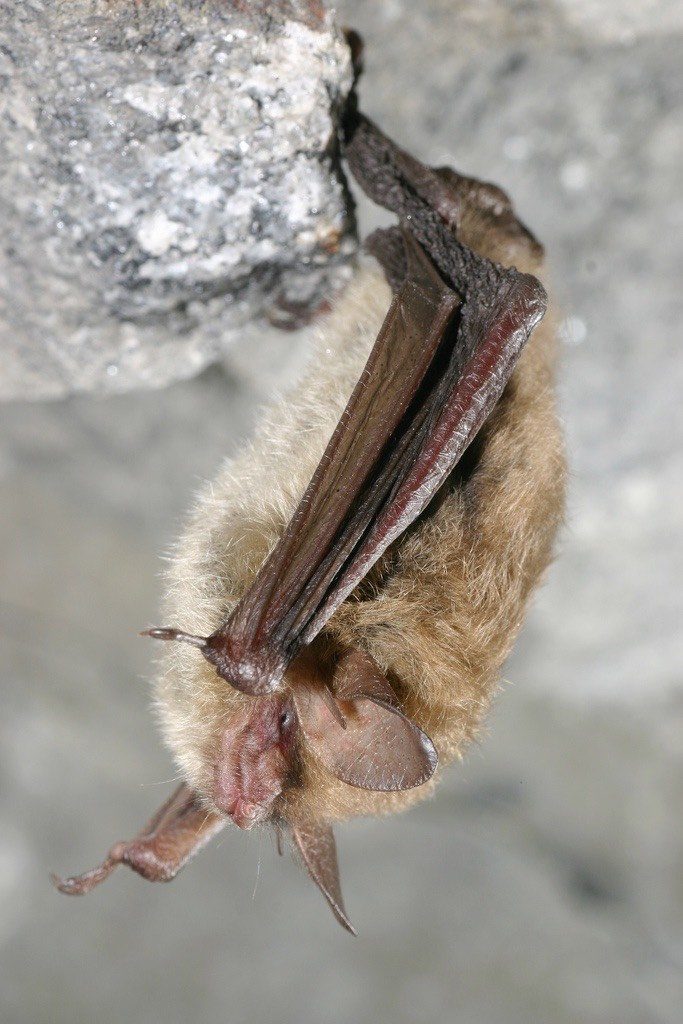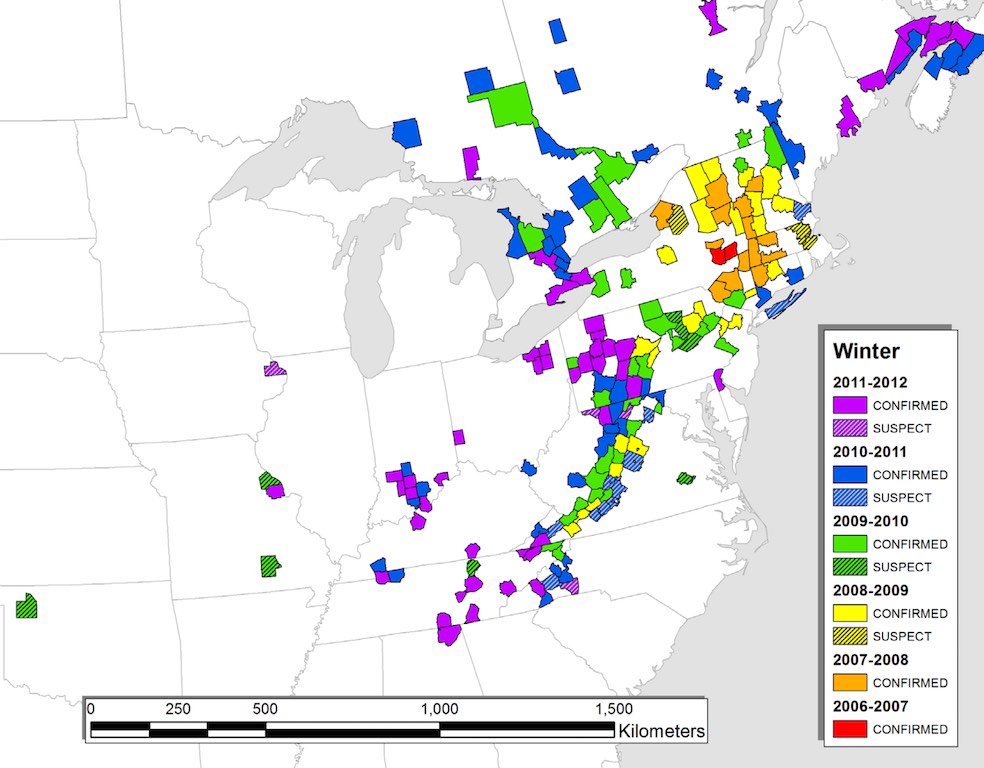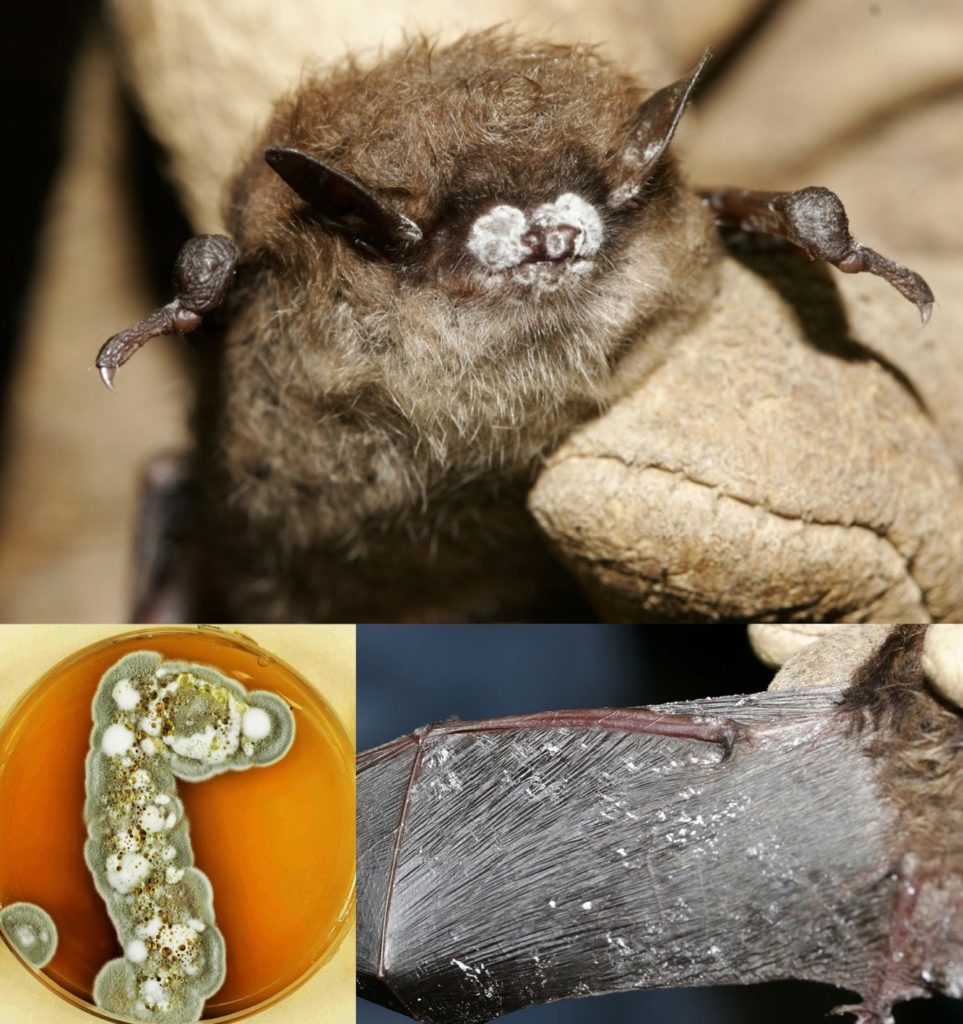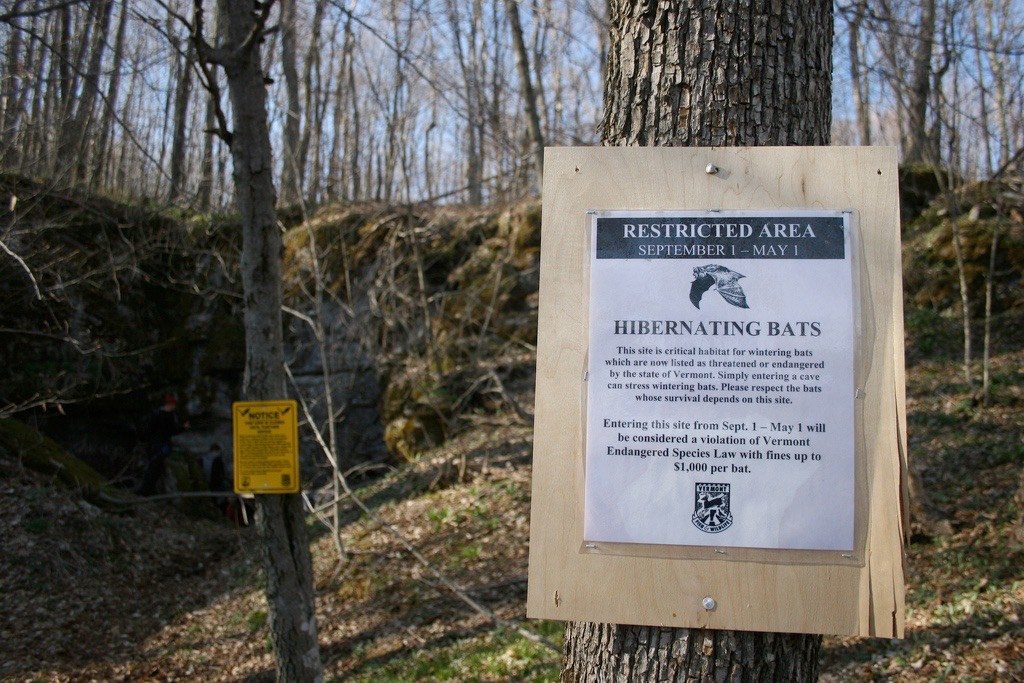Population Ecology
5.6 White-Nose Syndrome in North Americans Bats
Samantha K. Runser
In 2006, scientists discovered a disease that has the potential to devastate multiple species of hibernating bats in North America. The disease is known as white-nose syndrome and it is extremely lethal to bat populations. The loss of bat populations will have disastrous effects on many ecosystems.

Photograph by Al Hicks, 2007. CC BY 2.0.
Bats play an integral part in many North American ecosystems, including in the eastern United States. They are responsible for keeping insect populations including mosquitos and moths under control. Some bat species also help with seed distribution and pollination of flowers and plants. Many species of bats are considered to be keystone species, and therefore are vital to their ecosystems. However, a recently discovered disease is threatening the existence of bats and may ultimately jeopardize entire ecosystems.
In 2006, scientists in New York discovered and documented a series of caves that showed evidence of white-nose syndrome. Originally, white-nose syndrome (WNS) was isolated to a few caves in New York. However, the disease has now spread to 22 states and several Canadian provinces1,2 (Figure 2). There are seven North American bat species that are affected by WNS including the big brown bat (Epitesicus fuscus), the little brown bat (Myotis lucifugus) (Figure 3), the northern long-eared bat (Myotis septentrionalis) (Figure 1), the Indiana bat (Myotis sodalis), eastern small-footed bat (Myotis leibii), gray bat (Myotis grisescens), and the tri-colored bat (Perimyotis subflavus).3 All these bats species hibernate.3

Since the winter of 2006-2007 (red), white-nose syndrome has been confirmed in numerous Eastern U.S. states and in several Canadian territories. Histopathology analysis and PCR are used to detect the presence of WNS and the fungus that causes the disease.
Modified from P. M. Cryan et al., 2013. CC BY 2.0.
To determine if bats have been infected by WNS, scientists search for noticeable patches of skin erosion that include visible white fungal growth on the bat’s muzzle, wings, and ears4 (Figure 3). They also take tissue samples and search for significant losses in muscle tissue as well as discoloration.4 Infected bats demonstrate irregular behavior such as flying during the day, have frequent interruptions during normal hibernation periods, and exhibit sporadic flight patterns.4
Scientists have debated the cause of WNS. The fungus they believe to be responsible for WNS is known as Pseudogymnoascus destructans (formerly known as Geomyces destructans)4 (Figure 3). When the disease was first documented in 2006, several scientists hypothesized that the outbreak was caused by a genetic mutation in the fungus P. destructans. Fungal samples were taken from seven different caves in New York. The scientists grew the fungus for a year and then assembled the nucleotide sequences in the DNA. Through analysis of the DNA, the scientists discovered a repeating sequence of ten genes that were connected as a single clonal genotype in the P. destructans population.5 The scientists suggest that the rapid spread to nearby caves was caused by the gene in the fungus that replicated very efficiently. Furthermore, data implied that the fungus was spread to other caves by natural channels such as through air, soil, and water.5

Photographs by Ryan Von Linden, 2008. CC BY 2.0 (Top and Right) and D. B. Radabaugh, 2013. CC BY-SA 3.0 (Left).
Other scientists developed an alternate hypothesis regarding the cause and spread of the fungus. They suggest the outbreak was caused by anthropogenic means. These scientists used genetic markers to track the spread of the disease and deduced that P. destructans originated in Europe and was accidentally transported to the United State by humans. The first infected sites were popular commercial caves that saw regular tourist activity, providing further evidence of a link between the spread of WNS and humans.6 Presently, nearly all experts believe that the spread of WNS is a combination of both hypothesizes, however more research needs to be completed to confirm these findings.
WNS has had devastating effects on hibernating bat species in North America. It is estimated that at least 5 million North American bats have perished due to WNS, with mortality rates often exceeding 90 percent.7 To assess this dramatic loss of life, considerable bat counting experiments were performed and hazard models were created and analyzed. These experiments tested the association between mortality rates and the size of bat colonies. Population sizes ranged from less than 1000 bats to over 5000 bats.8 Findings suggest that colonies with greater concentrations of bats had higher mortality rates than those with fewer individuals.8 These experiments confirmed the lethality of WNS and also its effectiveness at annihilating large bat populations in a short time period.
With drastically high mortality rates from WNS, researchers are calculating if several bat species will be at risk of extinction.7 The two bat species that are most affected by WNS are the little brown bat and the endangered Indiana bat. The Indiana bat population model suggests that in the next 20 years over 90 percent of the population will encounter WNS, and in less than 50 years the total population will decline by 69 percent.7
Similar trends are present in little brown bat populations. In one experiment, five different scenarios were simulated with each scenario having a different mean decline rate. At the highest decline rate of 45 percent, it was estimated that there was a 99 percent chance the species would be extinct within the next 16 years.8 However, even if the mortality rate decreases over time, the regional population is estimated to radically change in less than 20 years.8 Populations may decline from 6.5 million individuals to less than 65,000 individuals.8

Photograph by Ann Froschauer, 2012. CC BY 2.0.
If immediate action is not taken to prevent the spread of WNS, hibernating bats in North America may face extinction. If bats were to disappear completely it would have numerous negative impacts on the entire ecosystem. Insect populations left uncontrolled would consume plants and foliage at a rapid rate, leading to further problems. To help combat the spread of WNS, several states have shut down caves from public access.9 Labs are developing vaccines and antibiotics to help save the bats.6 It is promising for the future of North American bat populations that alleviating actions are underway, but it is vital that a definitive solution to WNS be discovered before these bats are extinct.
References
- Blehert, D.S., et al. (2008). Bat White-Nose Syndrome: An Emerging Fungal Pathogen, Science, 328:227
- Raudabaugh, D.B., & Miller, A.N. (2013). Nutritional capability of and substrate suitability for Pseudogymnoascus destructans, the causal agent of bat white-nose syndrome. Plos One,8:10.
- Turner, G.G., et al. (2011). A Five-year Assessment of Mortality and Geographic Spread of White-nose Syndrome in North American Bats and a Look to the Future. Bat Research News, 52:13-27.
- Cryan, P.M., et al. (2013). White-nose syndrome in bats: illuminating the darkness. BMC Biology, 11:47.
- Rajkumar, S., et al. (2011). Clonal genotype of Geomyces destuctans among bats with white nose syndrome, New York, USA. Emerging Infectious Diseases, 17:1273-1276.
- Eskew, E.A. & Todd, B.D., (2013). Parallels in Amphibian and Bat Declines from Pathogenic Fungi. Emerging Infectious Diseases. 19:379-385.
- Thogmartin, W.E., et al. (2013). White-nose syndrome is likely to extirpate the endangered Indiana bat over large parts of its range. Biological Conservation. 160:162-172.
- Wilder, A.P., et al. (2011). Risk factors associated with mortality from white-nose syndrome among hibernating bat colonies. Biology Letters. 7:950-953.
- Frick, W.F., et al. (2010). An Emerging Disease Causes Regional Population Collapse of a Common North American Bat Species. Science, 329:679-682.
- Hicks, Al. (2007). [Photograph of a healthy northern long eared bat]. Retrieved from FlickrCommons. © U.S. Fish and Wildlife Service. CC BY 2.0.
- Cryan, P.M., et al. (2013). The spread of bat white-nose syndrome and the fungus (Geomyces destructans) that causes the disease. [Map]. Retrieved from http://www.biomedcentral.com/1741-7007/11/47 © 2013 Cryan et al; licensee BioMed Central Ltd. CC BY 2.0. Modifications: Cropped.
- Von Linden, Ryan, New York Department of Environmental Conservation. (2008). Little brown bat; close-up of nose with fungus. [Photograph]. Retrieved from FlickrCommons. © U.S. Fish and Wildlife Service. CC BY 2.0.
- Raudabaugh, DB. (2013). [Photograph of a Pseudogymnoascus destructans culture]. Retrieved from Wikimedia Commons. CC BY-SA 3.0.
- Von Linden, Ryan, New York Department of Environmental Conservation. (2008). Little brown bat; fungus on wing membrane. [Photograph]. Retrieved from FlickrCommons. © U.S. Fish and Wildlife Service. CC BY 2.0.
- Froschauer, Ann. (2012). Cave closed signs. [Photograph]. Retrieved from FlickrCommons. © U.S. Fish and Wildlife Sercive. CC BY 2.0.
